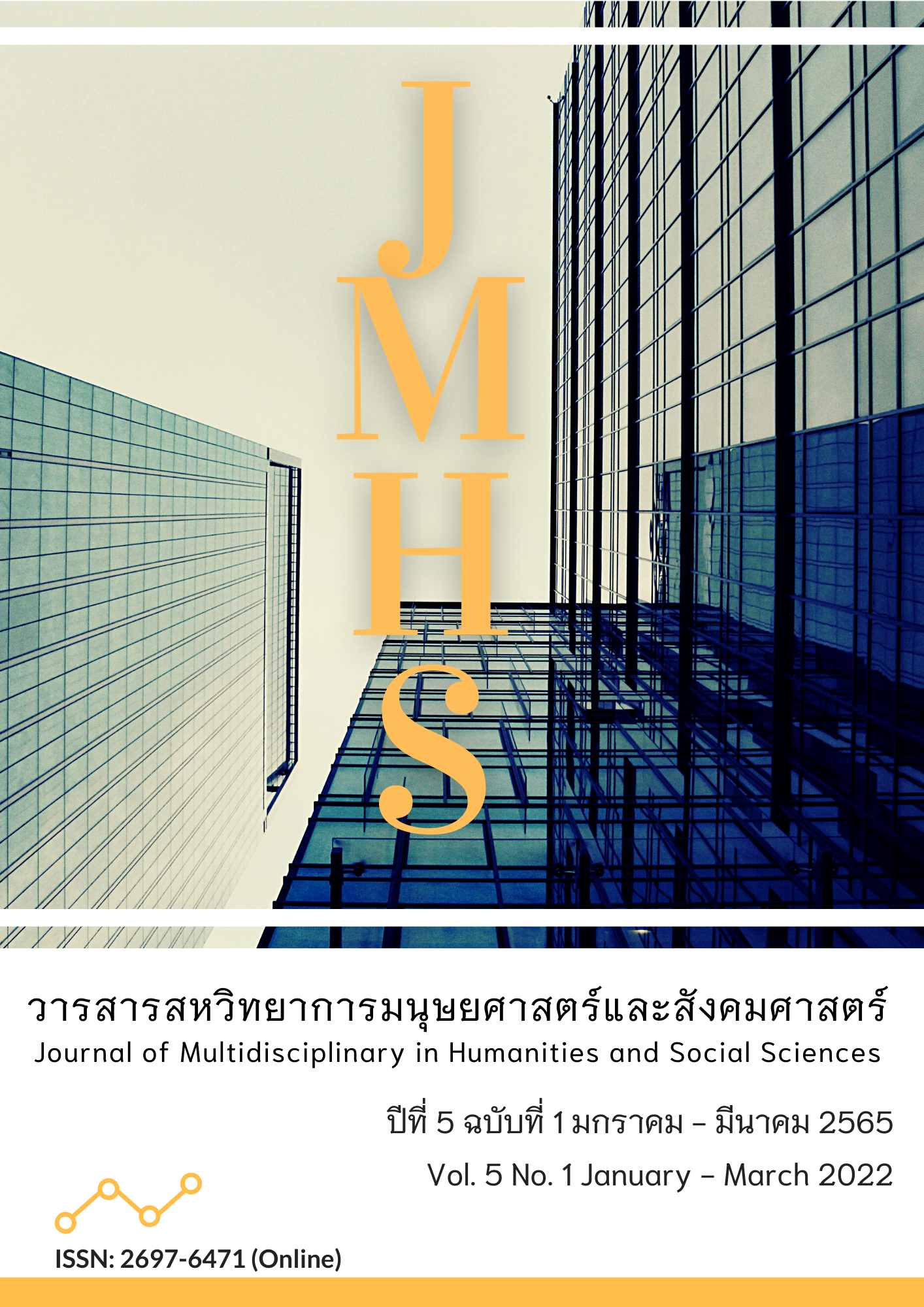Building the Systems, Mechanism and Networking Model for Collaborative Educational Administration of Educational Service Office Area in Kanchanaburi Province
Main Article Content
Abstract
The purposes of this research were: (1) to develop the systems and mechanisms for collaborative educational administration of the Educational Service Office Area in Kanchanaburi Province; and (2) to develop the networking model for collaborative educational administration of the Educational Service Office Area in Kanchanaburi Province. It can be categorized as a descriptive research design. The respondents were used as the unit of analysis. The research sample consisted of 36 pilot schools in the educational sandbox of Kanchanaburi Province. The respondents were classified into 2 levels: there were 6 people in each educational service area and 6 people in each school, for a total of 258. The research instrument was a questionnaire. The statistics used to analyze the data were exploratory factor analysis, confirmatory factor analysis, and path analysis.
The research findings were as follows: 1. components of systems for collaborative educational administration of the Educational Service Office Area in Kanchanaburi Province comprised networking management, and networking commitment, while components of the mechanism for collaborative educational administration of the Educational Service Office Area in Kanchanaburi Province comprised networking structure, leadership, and member roles.
2. The networking model for collaborative educational administration of the Educational Service Office Area in Kanchanaburi Province found that the causal effects factors influencing networking commitment were networking management, networking structure, member roles, and leadership, respectively.
Article Details

This work is licensed under a Creative Commons Attribution-NonCommercial-NoDerivatives 4.0 International License.
Views and opinions appearing in the Journal it is the responsibility of the author of the article, and does not constitute the view and responsibility of the editorial team.
References
กชกร เดชะคำภู และ ทิพาภรณ์ หอมดี. (2560). กลไกการมีส่วนร่วมของชุมชนในการจัดการพื้นที่สาธารณะ “หาดเห่” เกาะกลางแม่น้ำโขง. วารสารวิจัยเพื่อการพัฒนาเชิงพื้นที่, 9(5), 347-360.
กระทรวงศึกษาธิการ. (2562). โครงการพื้นที่นวัตกรรมการศึกษา “สนามปฏิบัติการเพื่อสร้างนวัตกรรมการศึกษาของประเทศ”. (เอกสารอัดสำเนา)
จิรภัทร มหาวงศ์ และคณะ. (2559). การพัฒนารูปแบบการบริหารเครือข่ายความร่วมมือทางวิชาการของโรงเรียนในถิ่นทุรกันดารบนเขตพื้นที่สูง. วารสารศึกษาศาสตร์ มหาวิทยาลัยนเรศวร, 18(4), 114-127.
ชรินทร์ มั่งคั่ง. (2561). กลยุทธ์ขับเคลื่อนเครือข่ายการเรียนรู้ของครูสังคมเพื่อพัฒนาคุณภาพการศึกษาผู้เรียนในโรงเรียนมัธยมศึกษา. วารสารการวิจัยเพื่อพัฒนาชุมชน (มนุษยศาสตร์และสังคมศาสตร์), 11(3), 63-75.
นพปฎล บุญพงษ์ และคณะ. (2560). การนำเสนอรูปแบบการบริหารเครือข่ายสถานศึกษาของสำนักงานเขตพื้นที่การศึกษาประถมศึกษา. ราชภัฏเพชรบูรณ์สาร, 19 (1), 14-21.
พิสิฐ เทพไกรวัล. (2554). การพัฒนารูปแบบเครือข่ายความร่วมมือเพื่อคุณภาพการจัดการศึกษาในโรงเรียนประถมศึกษาขนาดเล็ก(วิทยานิพนธ์ปรัชญาดุษฎีบัณฑิต). มหาวิทยาลัยขอนแก่น.
พีรพัฒน์ รุ่งเรือง และ วรรณวีร์ บุญคุ้ม. (2562). ยุทธศาสตร์การสร้างภาคีเครือข่ายในการจัดการ ศึกษาขององค์กรปกครองส่วนท้องถิ่น. วารสารศิลปากรศึกษาศาสตร์วิจัย, 11(2), 256-273.
ภัทรวรรธน์ นิลแก้วบวรวิชญ์. (2559). รูปแบบการพัฒนาเครือข่ายความร่วมมือทางวิชาการของสำนักงานเขตพื้นที่การศึกษาประถมศึกษาสังกัดสำนักงานคณะกรรมการศึกษาขั้นพื้นฐาน. วารสารศึกษาศาสตร์ มหาวิทยาลัยบูรพา, 27(3), 18-32.
พระราชบัญญัติพื้นที่นวัตกรรมการศึกษา พ.ศ. 2562. (30 เมษายน 2562). ราชกิจจานุเบกษา. เล่มที่ 136 ตอนที่ 56 ก.
สมศักดิ์ เอี่ยมดี และคณะ. (2556). การพัฒนาระบบการบริหารเครือข่ายการมีส่วนร่วมในการจัดการศึกษาของสำนักงานเขตพื้นที่การศึกษาประถมศึกษา. วารสารศึกษาศาสตร์ มหาวิทยาลัยนเรศวร, 15(พิเศษ), 216-224.
สุดา มงคลสิทธิ์. (2562). กลยุทธ์การสร้างเครือข่ายความร่วมมือเพื่อพัฒนาการจัดการศึกษาในโรงเรียนเอกชนจังหวัดชลบุรี. วารสารมหาจุฬานาครทรรศน์, 6(10), 5843-5859.
เสมา บุ้งทอง. (2563). การศึกษาองค์ประกอบของเครือข่ายการเรียนรู้ของโรงเรียนเอกชน. วารสารบริหารการศึกษา มหาวิทยาลัยขอนแก่น, 16(2), 66-79.
สำนักงานเลขาธิการสภาการศึกษา. (2562). รายงานการศึกษารูปแบบและกลไกการมีส่วนร่วมและสมัชชาการศึกษา. กรุงเทพฯ: พริกหวานกราฟฟิก.
Comrey, A. L., & Lee, H. B., (1992). A First Course in Factor Analysis. New Jersey: Erlbaum.
Habing, B. (2020). Exploratory Factor Analysis. Retrieved November 10, 2020, from http://www.stat.sc.eduhabing/courses/530EFA.pdf.
Hair, J. F. et al. (1998). Multivariate Data Analysis (5th ed.). New Jersey: Prentice-Hall.
Hatcher, L. (1994). A Step-by-Step Approach to Using the SAS System for Factor Analysis and Structural Equation Modeling. North Carolina: SAS Institute.
Kaiser, H. F. (1960). The Application of Electronic Computers to Factor. Educational and Psychological Measurement, 20, 141-151.
Lunenburg, F. C., & Ornstein, A. V. (2012). Educational Administration: Concepts and Practices. (6th ed.). California: Wadsworth Publishing.


